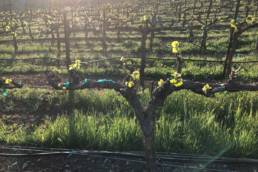FMN – November 2021 – Thanksgiving Feast Wines
After the appetizer of shoving candy into our gobs for Halloween, we now officially ebb into the beginning of the eating holidays. With the weather getting a bit colder you are more easily able to hide your beer belly or thunder thighs with the addition of layers of strategically placed clothes. There is no sense in denying yourself any holiday pleasures at this point when you can save that empty promise for your New Years resolution.
Since we are embracing our obesity, at least for the next few months, we can focus on sucking the proverbial (and literal) marrow out of life sans guilt. The next rung on the ladder towards culinary self-actualization would be selecting some wines to go along with our multi-day Thanksgiving food orgy. The fact that anyone would condone a “one-day-only” feast seems a bit Steinbeckian.
Although there are a myriad of choices and even some tremendous “go to” wines for Thanksgiving, I think the wines you serve say something about you. Anyone that knows me would agree that my wine selections, along with my personality, are a little different from the norm.
The first wine you pop and pour will set the tone, therefore I use this selection to remind those in attendance that wine can actually be fun. A Prosecco, specifically a rosé Prosecco, fits the bill quite well. I do love sparkling wine and am endeared to the autolytic yeasty, biscuit dough and brioche elements of fine Champagne, but in this case, I’m going for value and fun. They pair with almost any entry appetizers you’re serving and handing someone a glass of sparkling has a certain “welcome to my home, now stuff your gullet” type of feel.
Although it may sound sacrilegious, but some of your guests may not like sparkling wine. Insert eye roll here. We are attempting to be inclusive and do not want to judge so we have an alternative. This is a great opportunity to use a still rosé wine but maybe one slightly out of the ordinary. South of France has enjoyed success with many Americans drinking bucket loads of their rosé over the summer. I fall into that category and like to try different red varieties I love, made as rosé wines.
I think Malbec is one of the greatest success stories for a “newer” wine country, carving a substantial niche into the consumer market. These wines can be a great value for the level of quality you receive in the glass. For this reason, I went with a Malbec rosé; and your friends will gain that welcoming feeling that comes along with varietal recognition.
The Cinsault (Sin-so) grape has long existed in Languedoc-Roussillon and Provence-Côte d’Azur regions of France as a softer blending partner to Carignan. Identical to the ancient Spanish grape Sinsó, its drought tolerance has endeared it to winemakers throughout the Mediterranean. We can find it listed in the wines of North Africa (especially Morocco), contained in some famous well-known blends: Chateau Musar in Lebanon and as an accepted grape in Châteauneuf-du-Pape, and is the main black grape on the island of Corsica.
Once known as “Hermitage” in South Africa, it was crossed with Pinot Noir to produce the well-known Pinotage grape. It even found its way into some famous Burgundy wines during the 1960s and 70s when it was imported from Algeria to help support some of the more challenging vintages. Even with all that grandeur and exposure, I can count on one hand the amount of 100% Cinsault wines I have had the pleasure of tasting. If you have a chance to find a masochistic winemaker that makes this wine, and does it well, you will forever be on the hunt for more.
I spend almost all of my Thanksgivings with my second family, that just so happens to live by the water in the “Low Country” and also just so happens to be I-talian. So, I always try to find an unusual or obscure variety from their motherland to embody my ethical appreciation. This year I happened on a variety that, even after the thousands of wines I’ve tasted (I may be understating), I was completely unfamiliar.
Frappato is an ancient Sicilian grape variety that has managed to cling to a few hundred acres of vineyard area as many have already been lost to “international varieties”. Like many Sicilian wines, it usually is a component to a blend; most notably in Cerasuolo di Vittoria DOCG (30-50% of the blend). The light red wines produced from this grape maintain a bright, vibrant acidity even in the oppressive heat of southern Sicily.
Interestingly enough, recent genetic studies show a parent – offspring relationship between this grape and Sangiovese, not a crossing as once thought. Without a large global demand for Sicilian wines and the ever-lingering pressure placed on smaller producers, it amazes me that there are still producers brave enough to pay homage to their past by producing these wines. Along with the producers, you need forward thinking importers and distributers willing to take the time to hand-sell these wines instead of just selling the “low hanging fruit” (no pun intended). My hopes are that a domestic winemaker, with global warming stresses, will experiment with this variety and perhaps elevate it to its rightful place among the more well-established Italian varieties.
The final variety (a parent to gamay Noir) has been around since Medieval times and, although mostly found in Central Europe, enjoys a wide breadth of vineyard space across the world. Blaufränkisch (Austrian name), is the second most planted grape there and can be found as a varietal wine or contributing acidity, tannin and color to blends. Called Kékfrankos in Hungary, Franconia in northern Italy, and Lemberger in Germany (also in USA and Canada), this grape’s multiple colloquial names shows that it has been in existence in many countries for a long time.
Its ability to tolerate and ripen in cold climates, made it a popular black variety (along with Cabernet Franc), in some of our cooler, more challenging domestic regions. If not fully ripe or if overcropped, however, the resultant wines are thin, weedy, green and bracingly acidic. Perhaps this is why most U.S. consumers have never heard of or sampled any of this ancient variety. Honestly, there are many domestic versions that are drinkable but a miniscule amount that are truly stunning.
Unfortunately, our myopic view of “minor” holidays, causes us to look past these treasured excuses to gather and consume. I, for one, appreciate and celebrate all our holidays. Those vigilant and perceptive readers probably noticed that I chose five wines paying homage to Fibonacci Day (November 28th). And for the guys, remember not to spill too much food in your beard, it being no shave November. I’m fairly certain that it remains a male-only celebration but, for inclusion purposes, I guess give it a shot girls. I truly hope you appreciate and enjoy your days of Thanksgiving celebration.
Suggested Wines:
Valdo Marca Oro Prosecco DOC Rosé $14.99
This pale pink sparkler blends the traditional Glera grape with a small amount of Pinot Noir. There are aromas of orchard fruits (green apple), berry (cherry) and a slight citrus note. The palate is off dry with the perception muted due to the vibrant, mouth-watering acid structure. The mousse is persistent but not aggressive. There are flavors of tart cherry, apples, and candied blood orange. There is a medium finish that reevokes the citrus element. Pair with cured meats, fried appetizers, or that ever-tempting holiday cheese ball.
Coen Malbec Rosé 2020 Uco Valley $19.99
The inviting medium pink color open to aromas of red fruit (raspberry), watermelon and a green herbaceous note. The palate is bone dry with mouthwatering juicy tart acidity, medium plus body, medium intensity and flavors of tart cherry skin, green herbs, raspberry and raspberry leaf. The warm, herbaceous, tart acidic lingering finish begs for an accompaniment of food. Pair with fatty cured meats, herb infused soft cheeses, and fried food.
Corvo Irmàna Frappato Terre Siciliane IGT 2020 $12.99
Medium ruby color with aromas of berries (blackberry, mulberry), pomegranate, violets and a woody sweet spice. A little prickle in the nose may indicate a small touch of volatile acidity that elevates the aromatics. The palate is dry with tart mouthwatering acidity that builds the longer you hold the wine in your mouth. Medium minus body, medium intensity, well integrated alcohol, fine grained tannins that have an affinity for the gums. There are flavors of blackberry, blackberry stem, elderberry, and dried woody herbs. A truly interesting wine that would pair well with quail, turkey (especially the dark meat) with cranberry sauce, wild mushroom dishes, sage infused dressing and pork tenderloin.
Cinsault 2017 – Yakima Valley AVA, Washington – Tasting Room Price $25.00
The aromas convey elegance, which is the strength of this wine. There are nuances of sweet raspberry sauce, a slight floral nose, a touch of sweet spice (star anise) and green peppercorn. The slightly candied nose is a testament to their semi-carbonic maceration. The palate dry and ripe with a medium body and tart evident acidity. The tannins are fine-grained and well-tamed. The flavors mirror the nose with a raspberry / raspberry leaf finish. Truly a gem when one realizes how difficult it is to get right as a varietal wine. Pair this wine with fried turkey, mousse pâté, and baked ham.
Blaufränkisch 2017 – Yakima Valley AVA, Washington – Tasting room price $25.00
One first notices the aromatics are overt and seem to leap from the glass. There are aromas of blueberry, red currant, baking spice (allspice), some cigar box notes and a hint of dried herbs. The palate is dry with a slight perception of residual sugar but I feel that’ truly the ripeness of the grapes. The acidity is broad and structural, marrying well to the medium plus body. The tannins have a tongue affinity but are fine grained and unobtrusive. There are flavors of red currant, raspberry, elderberry, pie spices, and a sturdy herbal finish. This is one of my favorite grapes that no one celebrates but can be a party stopper in a blind tasting. Pair with the lamb you cook on Saturday (after being tired of turkey), rib roast or a great burger wine.




